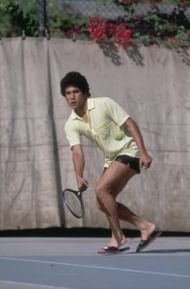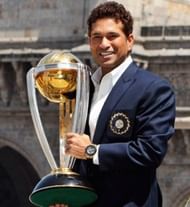And finally, it’s time to reveal the player at the No. 1 position in our series on the greatest cricketers of all time!
No. 1 – Sachin Tendulkar
“Beneath the helmet, under that unruly curly hair, inside the cranium, there is something we don’t know, something beyond scientific measure. Something that allows him to soar, to roam a territory of sport that, forget us, even those who are gifted enough to play alongside him cannot fathom. When he goes out to bat, people switch on their TV sets and switch off their lives.” – British broadcasting corporation (BBC).
My earliest memory of Sachin Tendulkar is silence. Not an empty silence but one that was laden with enormous amounts of anticipation and excitement, while being surrounded by a bunch of people staring intently at a television screen. That is what his arrival at the crease would do for a nation that was starved of success, starved of heroes. And yet, the silence seldom lasted very long. Boundaries would inevitably start to flow and those silences would be punctuated with raucous cheers that would resound throughout the country. Even my infantile mind at the time registered the fact that the cricketer I was watching was somehow different from the others. Vastly different in ability and freakishly different in the devotion he evoked.
It is not widely known, but Sachin’s first love was not cricket but tennis. An ardent fan of John McEnroe, he would spend hours with a racquet in hand, pretending to be at Wimbledon. In fact, he was enrolled at a cricket academy just to be kept busy and out of mischief. What transpired later is a classic example of one sport losing what another gained. Sachin took Mumbai’s formidable school cricket leagues by storm. He was drafted into the Mumbai cricket team with high expectations and he duly complied by scoring centuries on debut in each of the domestic cricket competitions. By this time, it was not a question of whether he would play for India, it was a question of when. And thus, at the age of sixteen, Sachin embarked upon a fairy-tale journey; a journey that continues to this day.
It is very important to understand why his arrival was so sorely needed and widely welcomed. India in 1989 had little reason to celebrate about. The economy was still not liberalized and the miraculous triumph in the 1983 World Cup seemed like a distant memory. The mindset of the Indian cricket team was defensive and a draw in a Test match was considered equivalent to victory. The one man who could win matches with his aggression was Kapil Dev and even he had slowed down with age. And then arrived Tendulkar like a breath of fresh air, demonstrating that strike-rates above 100 could actually be achieved and that taking the game to the opposition was the way to go. He showed that one could possess classic technique and yet be unorthodox at times. The Indian cricket fan began to believe that as long as Sachin was at the crease, a win was a distinct possibility and not just a pipe dream.
In the 1990′s, there was a saying that India’s batting started and ended with Sachin Tendulkar. The statement might be hyperbolic but it was born out of totally valid reasons. Dig into the records and you will frequently find scoreboards which show a ton against his name, with the rest failing to cross even twenty. He played the lone warrior umpteen times and often found himself on the losing side when the batting order capitulated after his dismissal. Who can forget the images of Sachin battling severe back pain in the Chennai Test of 1999 against Pakistan and making 136, only to see his team lose by 12 runs? Yet, he kept trying to lift a mediocre team all by himself and pulled it off many times. One such brilliant innings of 155 in a Test match prompted the erstwhile Aussie captain Mark Taylor to say, “We did not lose to a team named India; we lost to a man named Sachin Tendulkar”.
The dawn of the new millennium ushered in young and aggressive players who could share Sachin’s workload and this allowed him to mellow down. His famous tennis elbow injury prevented him from playing his full repertoire of shots. Many mistook this change in his style to be signs of decline but I simply attribute it to a change in his role in the team. There are now various attacking players at the team’s disposal and Tendulkar’s immense experience is better off playing a guiding role in the innings. This is not to say that his aggression has waned in any way. He can still pull out shots, like the upper cut, from his vast arsenal, and can modify his game as per the team requirements. The best example of this gear-changing ability was demonstrated in the victorious World cup 2011 campaign, in which Sachin’s swift contributions at the top played a major role.
Listing out Tendulkar’s numerous records will be akin to insulting fans of the game as a majority of them know these by heart. But it is necessary to mention the century of hundreds. This is not merely a milestone, but an Everest that will serve as a reference point or even a guiding star for batsmen all over the world. About twenty years ago, such an achievement would have been considered as humanly impossible. Then again, he is considered beyond human throughout India and in many other parts of the world.
Tendulkar’s greatness is often compared to that of another modern-day legend: Brian Lara. I feel that comparing them is like comparing apples and oranges. Lara was like a flamboyant and majestic pendulum clock; you could see the chimes and the machinery operate furiously while working their magic. Tendulkar, on the other hand, is like a smooth and efficient Rolex, with optimization being the key. One may prefer one style over the other, but it does not make the other inferior.
I have practically grown along with Sachin’s career and I simply do not know how cricket will seem once he exits the stage. There is one thing that is sure though; the memories he will leave shall delight people for generations to come, and people like me will regale their grandchildren with stories of a man who became God; of a man who stopped a nation when he came out to bat.
And just to refresh your memories, here’s a highlights clip of that desert storm innings from 1998:
These are the other players who have made it so far:
No. 20 – Bill O’Reilly; No. 19 – Fred Trueman; No. 18 – Dennis Lillee; No. 17 – Sunil Gavaskar; No. 16 – Steve Waugh; No. 15 – Kapil Dev; No. 14 – Malcolm Marshall; No. 13 – Glenn McGrath; No. 12 – Imran Khan; No. 11 – Brian Lara; No. 10 – Jack Hobbs; No. 9 – Adam Gilchrist; No. 8 – Wasim Akram; No. 7 – Ricky Ponting; No. 6 – Muttiah Muralitharan; No. 5 – Shane Warne; No. 4 – Vivian Richards; No. 3 – Sir Garfield Sobers; No. 2 – Sir Don Bradman
Read the detailed write-ups on all the players in this list here:
The greatest cricketers of all time
Follow IPL Auction 2025 Live Updates, News & Biddings at Sportskeeda. Get the fastest updates on Mega-Auction and cricket news


